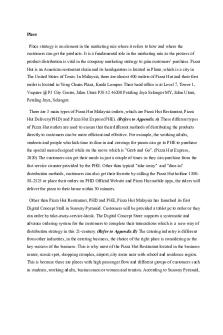Hybrid and Blended Learning: Modifying pedagogy across path, place, time, and place PDF

| Title | Hybrid and Blended Learning: Modifying pedagogy across path, place, time, and place |
|---|---|
| Author | W. Ian O'Byrne |
| Pages | 5 |
| File Size | 367.8 KB |
| File Type | |
| Total Downloads | 75 |
| Total Views | 302 |
Summary
MULTILITERACIES Hybrid and Blended Learning Modifying Pedagogy Across Path, Pace, Time, and Place W. IAN O’BY RNE & K RIST INE E. PY TASH T to increase students’ access to technology, acquiring im Flanagan is a seventh-grade English several Chromebook carts. At the same time, Tim language arts t...
Description
Accelerat ing t he world's research.
Hybrid and Blended Learning: Modifying pedagogy across path, place, time, and place W. Ian O'Byrne, Kristine Pytash
Related papers
Download a PDF Pack of t he best relat ed papers
Research on Lit eracy Inst ruct ion and Learning in Virt ual, Blended, and Hybrid Learning Environ… W. Ian O'Byrne A Proposed Blended Educat ional Framework for Administ rat ion of Ent erprises in Nowadays’ Greek Fin… Evgenia Papadopoulou, Avgoust os Tsinakos BLENDED LEARNING Assessing t he Value of Virt ual Worlds for Dist ance Educat ion St udent s t hrough C… Avgoust os Tsinakos
MULTILITERACIES
Hybrid and Blended Learning Modifying Pedagogy Across Path, Pace, Time, and Place W. IAN O’BY RNE & K RIST INE E. PY TASH
T
im Flanagan is a seventh-grade English language arts teacher in Stonington, Connecticut. He has been working to improve instruction in his classroom for a number of years and recently decided to return to school to build up his skill set as an educator. He was very interested in global education and technology, and as he searched, he looked for programs that would adapt to his schedule as an educator. Tim was not interested in traditional higher education or professional development series chronotopes dictating that he needed to be present at a specific place and time. He wanted something that would break away from traditional learning practices and allow him to negotiate different times, spaces, and places and use diverse tools situated in his life. Tim ultimately entered the Instructional Technologies & Digital Media Literacy Program, designed as a hybrid, or blended, learning program. He had already heard about hybrid learning and was excited to see how this was different from a tradiAuthors (left to right) tional online learning W. Ian O’Byrne is an assistant professor of literacy education at experience. Tim also the College of Charleston, SC, USA; believed that the proe-mail [email protected]. gram would help him Kristine E. Pytash is an assistant professor of teaching, learning with the current goals and curriculum studies at Kent State University, OH, USA; e-mail in his classroom. His [email protected]. school district wanted
The department editor welcomes reader comments. W. Ian O’Byrne is an assistant professor of literacy education at the College of Charleston, SC, USA. His research investigates the literacy practices of individuals as they read/write in online spaces. You can contact him via e-mail at wiobyrne@ gmail.com or on Twitter (@wiobyrne).
to increase students’ access to technology, acquiring several Chromebook carts. At the same time, Tim began noticing students’ advanced online literacy practices, such as social media, fan fiction writing forums, and video-gaming communities, and wanted to include these interests in his teaching. For more information on the Instructional Technologies & Digital Media Literacy Program, visit this blog post: wiobyrne.com/itdml. Tim focused on authentically and effectively embedding technology into his classroom instruction. Students’ technology access and motivation challenged him to consider how to best adapt what he was learning in his coursework to his classroom, yet he enthusiastically wanted to implement these learning experiences. He began building a hybrid learning model and decided that a significant amount of his students’ online learning would occur on Google Docs (https://www.google.com/docs/about) as a space for writing and editing. In addition, Tim created a workshop period called Digital Texts and Tools, allowing him to work with students to explore digital tools and ultimately allowing students to create online tutorials using screencasting. Although Tim has experienced a number of challenges, he continues to explore how hybrid models will best help him meet students’ educational goals. To learn more about Tim and connect with him online, you can visit his website: timflanagan.flavors.me.
What Is Hybrid Learning? Hybrid learning is a pedagogical approach that combines face-to-face (F2F) instruction with computer-mediated instruction (Ferdig, Cavanaugh, & Freidhoff, 2012). The terms blended learning, hybrid learning, and mixed-mode learning are used interchangeably in current research; however, in the United States, hybrid learning is used most often
Journal of Adolescent & Adult Literacy 59(2) September/October 2015 doi:10.1002/jaal.463 © 2015 International Literacy Association (pp. 137–140)
137
J OURN AL O F A DOL E SCE NT & A DULT L ITE RACY
5 9 (2 ) SE PTEMBER/OCTOBER 2015
MULTILITERACIES
138
(Martyn, 2003). Although hybrid learning can be diverse in how it is implemented, educators agree that this approach is “any time a student learns at least in part at a supervised brick-and-mortar location away from home and at least in part through online delivery with some element of student control over time, place, path, and/or pace” (Staker, 2011, p. 5). Hybrid learning models are expanding as many educators, like Tim, are creating online environments for their students. Although this model is relatively new, the goal is similar to other educational innovations: “for helping teachers achieve what they strive to do every day—deeply understand and enable each student they work with to reach the very highest levels of educational mastery” (Powell, Rabbitt, & Kennedy, 2014, p. 6). Yet, researchers tout that hybrid learning has the potential to provide a transformative experience in which new modes of education can challenge teachers to consider the best ways to educate students. Much of the power in hybrid learning comes from modification or manipulation of time, space, and place to improve teaching and learning. Asynchronous and synchronous learning events have different properties that may be exploited for different pedagogical purposes (Sotillo, 2000). Synchronous refers to real-time communication that mimics elements of a conversation or discussion (Mason, 1994; Riva, 2002). Using digital texts and tools, synchronous learning is only possible when using text, video, or audio chats. Asynchronous refers to communication of learning activities that occur outside of real time (Curtis & Lawson, 2001; Warschauer, 1997). Digital texts and tools that encourage asynchronous learning include videos, bulletin boards, readings, and writing or blogging activities. Asynchronous learning events allow the educator to build in elements of metacognitive delay, in turn allowing learners to “press pause” on learning or perhaps delay an immediate response. Although these are different ways to structure an online experience, in the hands of experienced teachers, both modes of [computer-mediated communication (i.e., synchronous and asynchronous)] can be used as novel tools to enhance the learning acquisition process by encouraging interaction among participants, collaborative text construction, and the formation of electronic communities of learners. (Sotillo, 2000, p. 82)
Hybrid learning should be viewed as an intermediate step between fully F2F and fully online learning environments. Although there is no perfect
or mandatory mixture, the best approach is one that attends to student learning objectives and scaffolds learners (Garrison & Kanuka, 2004). The purpose of this column is to consider the affordances and constraints that teachers like Tim encounter when they work to digitalize course content. For additional information on research and opportunities for literacy instruction in virtual, blended, and hybrid learning environments, visit this literature review and webinar: wiobyrne.com/hybrid-learning-environments.
Pedagogical Considerations and Opportunities Often, educational technologies are incorporated in the classroom to provide opportunities for student learning to be independent, personalized, and sustainable (Graham, 2006; Heinze & Procter, 2004). Hybrid learning provides an opportunity for sustainable, disruptive transformation of some of the challenges that permeate teaching and learning in traditional contexts. It should also be noted that simply by adding technology to instruction does not mean that all learners will be motivated or engaged. Integrating technology into the classroom should not drive instructional decision making; rather, pedagogical goals and objectives should determine whether a hybrid model is the best instructional design. Hutchison and Woodward (2014) argued that when incorporating any digital technology into the classroom, the instructional goal should be the first consideration and also provide the impetus for reflection after the tool has been implemented. This can be true of hybrid learning models. Educators must consider their objectives, learning outcomes, and why this instructional model is most effective for student learning and engagement.
Models for Hybrid Learning Although educators and researchers are still experimenting with various forms of hybrid learning, it is important to note that there are multiple models for blending online and F2F instruction. One of the more comprehensive models (Staker, 2011) details six versions of hybrid learning: F2F driver, rotation, flex, online lab, self-blend, and online driver.
Teacher Development Considerations and Opportunities Although the six models provide a glimpse at current ways to structure hybrid learning, it is important to
find resources. For more information on considerations for building your digital learning hub, review this webpage: wiobyrne.com/building-your-hub. Once you have your teaching and learning materials uploaded and embedded on your learning hub, start folding them into your classroom instruction. Have students read a website or document online as opposed to in class. Have them review a video online and come in to class prepared to discuss. Creating opportunities for hybrid learning allows you to assess how changing time, place, space, and modes affects instructional objectives. Continue to modify and iterate your design and materials based on student performance.
Conclusion As technology increasingly modifies aspects of path, pace, time, and place in our own lives, it also is affecting spaces for teaching and learning. Many teachers, including preservice teachers coming out of methods courses and inservice teachers in graduate work or professional development opportunities, are enrolling in hybrid learning programs. In turn, teachers are increasingly trying to identify opportunities to embed learning experiences for their students that blend F2F and online environments. To gain this knowledge and experience, teachers similar to Tim are enrolled in graduate programs with the emphasis of online learning in their teaching delivery and pedagogical focus. In addition to formal education or professional development, many teachers are also participating in online learning communities via Twitter, Google+, or massive open online courses to learn more about engaging students in hybrid learning opportunities. However, this is not always as simple as reproducing what has been done. Teachers, like Tim, who are enthusiastic about using technology to create hybrid learning opportunities still have to weigh the affordances and constraints of creating these environments for their students. Regardless of the methods and means by which educators experience and connect with hybrid learning, there needs to be a focus on instructional objectives. As online education and massive open online courses take off, we fear a growing sense that good pedagogy might not be as important in online and hybrid learning experiences. Sometimes there is a belief that if we just put computers in front of students, or “get an app for it,” they will learn. There may be a devaluing of the importance and effect of pedagogy and instructional design in hybrid learning.
Hybrid and Blended Learning: Modifying Pedagogy Across Path, Pace, Time, and Place
note that research shows that there is no one perfect method to balance out F2F and online instruction in a way that is perfect in every situation (Garrison & Kanuka, 2004). Most importantly, teachers need to be trained and given the pedagogical liberty to utilize traditional classroom methods while engaging in enhanced training to develop skills targeted for online and hybrid learning environments (Kennedy & Archambault, 2011). Watson (2007) indicated the following additional skills needed by educators as they build, teach, and learn in hybrid spaces. First, educators and students need to build enhanced communication skills. Participants cannot rely on nonverbal or proximal cues to address misunderstandings. Second, time management may be a challenge in asynchronous classes. Students can be online at any time, so teachers cannot predict when heavier workloads will occur. Third, teacher planning time needs to be extended and enriched. Most hybrid lessons need to include a multimedia component, which may require additional planning. Fourth, educators must be prepared to differentiate for different learning styles or abilities. Teachers must be able to adapt online content for reaching students with physical or learning disabilities. Although this may seem like an insurmountable goal, getting started is really quite easy. Our advice is to begin by reviewing and digitizing digital copies of all of your teaching and learning materials. As you review teaching materials, rebuild those that may not be effective. This might include using and sharing on Google Docs or uploading materials to websites such as SlideShare (www.slideshare.net) or Scribd (https:// www.scribd.com). The important part is making documents easily accessible for students as they work online. We do not advise uploading documents as Word documents, PDFs, or PowerPoint files, as this can be problematic for students and colleagues because it requires that they download and use other software to access your materials. Google Docs allows you to upload existing documents, or begin using Google Apps (https://www.google.com/edu/products/productivitytools) to create and share materials. After reviewing and digitizing all of your teaching and learning materials, create one learning hub to house all of them. This means that each educator should have one website or blog where they save and embed all materials that will be shared with students. This ensures that students know where to access teaching materials without requiring students to follow a trail of bread crumbs and links across the Internet to
139
MULTILITERACIES Educators and students need to be given the latitude to teach and learn in these hybrid spaces while being protected and supported by schools. Ultimately, teachers and students bear an equal responsibility as they collaboratively learn and experiment in these evolving spaces. An appreciation is required for the complexities, pitfalls, advantages, and limitations inherent in using these online learning spaces. A thoughtful, highly trained educator might hold the key to identifying best principles and new horizons in hybrid learning. We need to empower educators and students to work together to collaboratively define and redefine what it means to be able to teach and learn across time, pace, path, and place.
J OURN AL O F A DOL E SCE NT & A DULT L ITE RACY
5 9 (2 ) SE PTEMBER/OCTOBER 2015
References
140
Curtis, D.D., & Lawson, M.J. (2001). Exploring collaborative online learning. Journal of Asynchronous Learning Networks, 5(1), 21–34. Ferdig, R., Cavanaugh, C., & Freidhoff, J. (2012). Lessons learned from blended programs: Experiences and recommendations from the field. Vienna, VA: iNACOL. Garrison, D.R., & Kanuka, H. (2004). Blended learning: Uncovering its transformative potential in higher education. The Internet and Higher Education, 7(2), 95–105. doi:10.1016/j.iheduc.2004.02.001 Graham, C.R. (2006). Blended learning systems: Definition, current trends, and future directions. In C.J. Bonk & C.R. Graham (Eds.), Handbook of blended learning: Global perspectives, local designs (pp. 3–21). San Francisco, CA: Pfeiffer.
Heinze, A., & Procter, C. (2004, September). Reflections on the use of blended learning. Paper presented at the Education in a Changing Environment Conference, University of Salford, UK. Hutchison, A., & Woodward, L. (2014). A planning cycle for integrating technology into literacy instruction. The Reading Teacher, 67(6), 455–464. doi:10.1002/trtr.1225 Kennedy, K., & Archambault, L. (2011). The current state of field experiences in K–12 online learning programs in the U.S. In M. Koehler & P. Mishra (Eds.), Proceedings of the Society for Information Technology & Teacher Education International Conference 2011 (pp. 3454–3461). Chesapeake, VA: Association for the Advancement of Computing in Education. Martyn, M. (2003). The hybrid online model: Good practice. EDUCAUSE Quarterly, 26(1), 18–23. Mason, R. (1994). Using communications media in open and flexible learning. New York, NY: Routledge. Powell, A., Rabbitt, B., & Kennedy, K. (2014). iNACOL Blended Learning Teacher Competency Framework. Vienna, VA: iNACOL. Riva, G. (2002). The sociocognitive psychology of computermediated communication: The present and future of technology-based interactions. Cyberpsychology & Behavior, 5(6), 581–598. doi:10.1089/109493102321018222 Sotillo, S.M. (2000). Discourse functions and syntactic complexity in synchronous and asynchronous communication. Language Learning & Technology, 4(1), 82–119. Staker, H. (2011). The rise of K–12 blended learning: Profiles of emerging models. San Mateo, CA: Innosight Institute. Retrieved from www.christenseninstitute.org/publications/ the-rise-of-k-12-blended-learning-profiles-of-emerging-models Warschauer, M. (1997). Computer-mediated collaborative learning: Theory and practice. Modern Language Journal, 81(4), 470–481. doi:10.1111/j.1540- 4781.1997.tb05514.x Watson, J. (2007). A national primer on K–12 online learning. Washington, DC: National Council on Online Learning....
Similar Free PDFs

Time and place of contract
- 16 Pages

Tuan Space and Place and Time
- 7 Pages
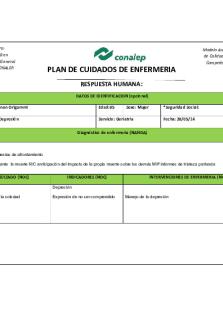
Depresion - PLACE
- 3 Pages

Asma - PLACE
- 2 Pages
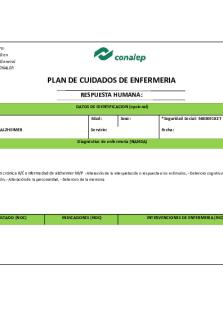
Alzheimer - PLACE
- 4 Pages
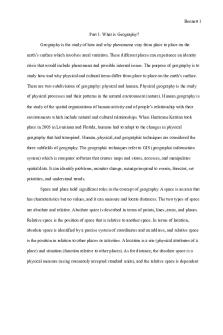
Geography/Place
- 3 Pages

Place-ejemplo de TB
- 4 Pages
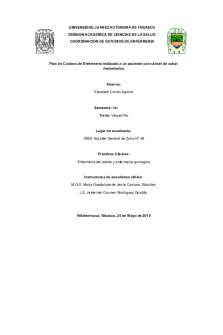
Place cancer de colon
- 40 Pages

Babcock Place - Grade: A
- 1 Pages

A Small Place
- 10 Pages

Artritis Reumatoide - PLACE
- 3 Pages
Popular Institutions
- Tinajero National High School - Annex
- Politeknik Caltex Riau
- Yokohama City University
- SGT University
- University of Al-Qadisiyah
- Divine Word College of Vigan
- Techniek College Rotterdam
- Universidade de Santiago
- Universiti Teknologi MARA Cawangan Johor Kampus Pasir Gudang
- Poltekkes Kemenkes Yogyakarta
- Baguio City National High School
- Colegio san marcos
- preparatoria uno
- Centro de Bachillerato Tecnológico Industrial y de Servicios No. 107
- Dalian Maritime University
- Quang Trung Secondary School
- Colegio Tecnológico en Informática
- Corporación Regional de Educación Superior
- Grupo CEDVA
- Dar Al Uloom University
- Centro de Estudios Preuniversitarios de la Universidad Nacional de Ingeniería
- 上智大学
- Aakash International School, Nuna Majara
- San Felipe Neri Catholic School
- Kang Chiao International School - New Taipei City
- Misamis Occidental National High School
- Institución Educativa Escuela Normal Juan Ladrilleros
- Kolehiyo ng Pantukan
- Batanes State College
- Instituto Continental
- Sekolah Menengah Kejuruan Kesehatan Kaltara (Tarakan)
- Colegio de La Inmaculada Concepcion - Cebu


